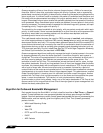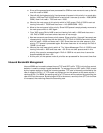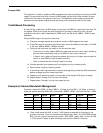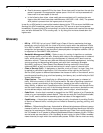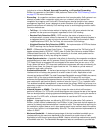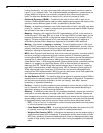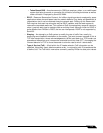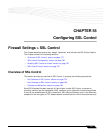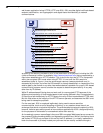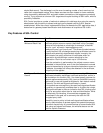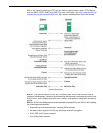
Firewall Settings > QoS Mapping
774
SonicOS 5.8.1 Administrator Guide
limiting functionality. You can now create traffic policies that specify maximum rates for
Layer 2, 3, or 4 network traffic. This enables bandwidth management in cases where the
primary WAN link fails over to a secondary connection that cannot handle as much
traffic.The Maximum Bandwidth can be set to 0%, which will prevent all traffic.
• Outbound (Egress or OBWM) – Conditioning the rate at which traffic is sent out an
interface. Outbound BWM uses a credit (or token) based queuing system with eight priority
queues to service different types of traffic, as classified by Access Rules.
• Priority – An additional dimension used in the classification of traffic. SonicOS uses eight
priority (0 = realtime, 7 = lowest) to comprise the queue structure used for BWM. Queues
are serviced in the order of their priority.
• Mapping – Mapping, with regard to SonicOS’ implementation of QoS, is the practice of
converting layer 2 CoS tags (802.1p) to layer 3 CoS tags (DSCP) and back again for the
purpose as preserving the 802.1p tags across network links that do not support 802.1p
tagging. The map correspondence is fully user-definable, and the act of mapping is
controlled by Access Rules. Mapping is supported on SonicWALL NSA platforms.
• Marking – Also known as tagging or coloring – The act of applying layer 2 (802.1p) or
layer 3 (DSCP) information to a packet for the purpose of differentiation, so that it can be
properly classified (recognized) and prioritized by network devices along the path to its
destination. Marking is supported on SonicWALL NSA platforms.
• MPLS - Multi Protocol Label Switching. A term that comes up frequently in the area of QoS,
but which is natively unsupported by most customer premise IP networking devices,
including SonicWALL appliances. MPLS is a carrier-class network service that attempts to
enhance the IP network experience by adding the concept connection-oriented paths
(Label Switch Paths – LSPs) along the network. When a packet leaves a customer premise
network, it is tagged by a Label Edge Router (LER) so that the label can be used to
determine the LSP. The MPLS tag itself resides between layer 2 and layer 3, imparting
upon MPLS characteristics of both network layers. MPLS is becoming quite popular for
VPNs, offering both layer 2 and layer 3 VPN services, but remains interoperable with
existing IPsec VPN implementation. MPLS is also very well known for its QoS capabilities,
and interoperates well with conventional DSCP marking.
• Per Hop Behavior (PHB) – The handling that will be applied to a packet by each DiffServ
capable router it traverses, based upon the DSCP classification of the packet. The behavior
can be among such actions as discard, re-mark (re-classify), best-effort, assured
forwarding, or expedited forwarding.
• Policing – A facility of traffic conditioning that attempts to control the rate of traffic into or
out of a network link. Policing methods range from indiscriminate packet discarding to
algorithmic shaping, to various queuing disciplines.
• Queuing – To effectively make use of a link’s available bandwidth, queues are commonly
employed to sort and separately manage traffic after it has been classified. Queues are
then managed using a variety of methods and algorithms to ensure that the higher priority
queues always have room to receive more traffic, and that they can be serviced (de-queued
or processed) before lower priority queues. Some common queue disciplines include:
–
FIFO – First In First Out. A very simple, undiscriminating queue where the first packet
in is the first packet to be processed.
–
Class Based Queuing (CBQ) – A queuing discipline that takes into account the CoS
of a packet, ensuring that higher priority traffic is treated preferentially.
–
Weighted Fair Queuing (WFQ) – A discipline that attempts to service queues using a
simple formula based upon the packets’ IP precedence and the total number of flows.
WFQ has a tendency to become imbalanced when there is a disproportionately large
number of high-priority flows to be serviced, often having the opposite of the desired
effect.



